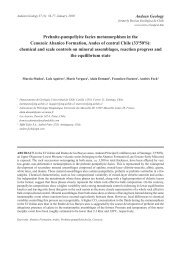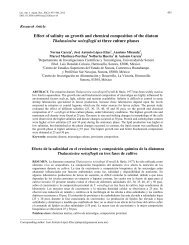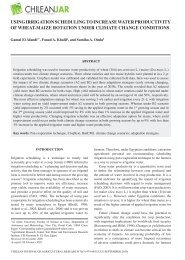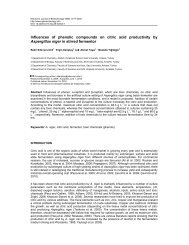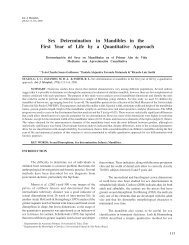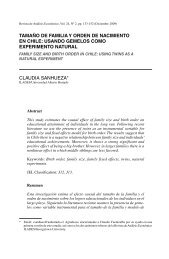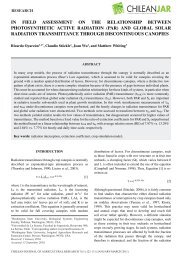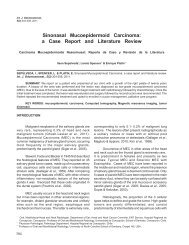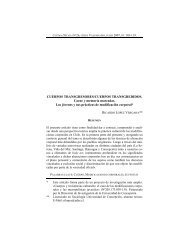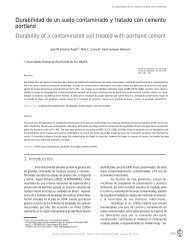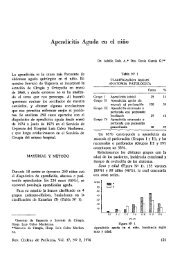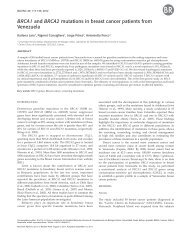Estimation of Cranial Capacity in 17-20 Years Old in South ... - SciELO
Estimation of Cranial Capacity in 17-20 Years Old in South ... - SciELO
Estimation of Cranial Capacity in 17-20 Years Old in South ... - SciELO
Create successful ePaper yourself
Turn your PDF publications into a flip-book with our unique Google optimized e-Paper software.
Int. J. Morphol.,<br />
23(4):301-304, <strong>20</strong>05.<br />
<strong>Estimation</strong> <strong>of</strong> <strong>Cranial</strong> <strong>Capacity</strong> <strong>in</strong> <strong>17</strong>-<strong>20</strong> <strong>Years</strong> <strong>Old</strong> <strong>in</strong> <strong>South</strong><br />
East <strong>of</strong> Caspian Sea Border (North <strong>of</strong> Iran)<br />
Estimación de la Capacidad Craniana en Individuos entre <strong>17</strong>-<strong>20</strong> Años de Edad<br />
del Sureste del Borde Costero del Mar Caspio (Norte de Irán)<br />
*<br />
Mohammad Jafar Golalipour; ** Mehrdad Jahanshaei & ** Kamran Haidari<br />
GOLALIPOUR, M. J.; JAHANSHAEI, M. & HAIDARI, K. <strong>Estimation</strong> <strong>of</strong> cranial capacity <strong>in</strong> <strong>17</strong>-<strong>20</strong> years old <strong>in</strong> <strong>South</strong> East <strong>of</strong><br />
Caspian Sea border (North <strong>of</strong> Iran). Int. J. Morphol., 23(4):301-304, <strong>20</strong>05.<br />
SUMMARY: It is natural that there is close relationship between cranial capacity, and the size <strong>of</strong> bra<strong>in</strong>, several studies have<br />
estimated the cranial capacity which <strong>in</strong>directly reflects the bra<strong>in</strong> volume <strong>in</strong> different countries. In the present study cranial capacity has<br />
been estimated <strong>in</strong> Turkmans and native Fars<strong>17</strong>-<strong>20</strong> years old groups <strong>in</strong> North <strong>of</strong> Iran.<br />
This study was carried out on 808 normal <strong>17</strong>-<strong>20</strong> years old (male 398, female 410) <strong>in</strong> Turkman and native Fars groups <strong>in</strong> <strong>South</strong>-<br />
East <strong>of</strong> Caspian Sea border (North <strong>of</strong> IRAN). By us<strong>in</strong>g l<strong>in</strong>ear dimensions <strong>of</strong> the head.<br />
The mean and SD <strong>of</strong> cranial capacity <strong>in</strong> Turkmans males and females were 14<strong>20</strong>.6±85 ml and 1227.2±1<strong>20</strong> ml, respectively. The<br />
mean and SD <strong>of</strong> cranial capacity <strong>in</strong> native Fars male and females were 1369±142ml, 1215.8±125ml, respectively, this difference was<br />
significant (P
GOLALIPOUR, M. J.; JAHANSHAEI, M. & HAIDARI, K.<br />
MATERIAL AND METHOD<br />
RESULTS<br />
This study was done on 401 healthy years old <strong>of</strong><br />
Turkman group (198 males, <strong>20</strong>3 females) and 407 healthy<br />
<strong>17</strong>-<strong>20</strong> years old <strong>of</strong> native Fars group (<strong>20</strong>0 males, <strong>20</strong>7<br />
females) <strong>in</strong> Gorgan <strong>South</strong>-East Caspian Sea border (North <strong>of</strong><br />
Iran), dur<strong>in</strong>g <strong>20</strong>02.<br />
Turkman’s population are liv<strong>in</strong>g for more than two<br />
centuries <strong>in</strong> this area, who immigrated from central Asia.<br />
Turkman people are only marr<strong>in</strong>g <strong>in</strong> <strong>in</strong>tra-group because <strong>of</strong><br />
religious and ethnic beliefs. Thus, they are nearly pure race.<br />
Native Fars group is population <strong>of</strong> native Fars that have been<br />
selected from amongst last three generations who lived <strong>in</strong> this<br />
zone. In each case the follow<strong>in</strong>g l<strong>in</strong>ear dimensions <strong>of</strong> the head<br />
were measured:<br />
1. Occipito-frontal circumference (OFC/head circumference)<br />
us<strong>in</strong>g a steel tap.<br />
2. Maximum head length (L) (Glabella <strong>in</strong>ion length).<br />
3. Maximum head breath (B) (measured between pariental<br />
em<strong>in</strong>ences): 2and 3 measured with a spread<strong>in</strong>g caliper.<br />
4. Auricular height (HT) (external acoustic meatus to the<br />
highest po<strong>in</strong>t <strong>of</strong> the vertex) us<strong>in</strong>g an auricular head spanner.<br />
Each measurement was taken to the nearest millimeter<br />
at least three times and the average was considered for<br />
computation.<br />
The cranial capacity was calculated us<strong>in</strong>g the follow<strong>in</strong>g<br />
formula given by Williams et al. (1995) and Manjunath, <strong>20</strong>02b.<br />
Males : 0.000337(L-11) (B-11) (HT-11) +406.01<br />
Females: 0.000400(L-11) (B-11) (HT-11) +<strong>20</strong>6.60<br />
The data for each person was recorded <strong>in</strong> a special form<br />
and then analyzed by Epi6. For comparison <strong>of</strong> the means <strong>of</strong><br />
anthropometric measurements T student Test (α=0.05) was<br />
used.<br />
Means and SD <strong>of</strong> head length, head width and Auricular<br />
height <strong>in</strong> both sex <strong>in</strong> Turkman group are depicted <strong>in</strong> Table<br />
I. Means and SD <strong>of</strong> cranial capacity were <strong>in</strong> males: 14<strong>20</strong>.6<strong>17</strong>1<br />
± 85.03cc (Range: 1334.5771-1505.6371cc), and <strong>in</strong> females:<br />
1227.2269 ± 1<strong>20</strong>.712cc (Range:1106.5149-1347.9389cc). That<br />
this difference was significant(p
<strong>Estimation</strong> <strong>of</strong> cranial capacity <strong>in</strong> <strong>17</strong>-<strong>20</strong> years old <strong>in</strong> <strong>South</strong> East 0f Caspian Sea border (North <strong>of</strong> Iran). Int. J. Morphol., 23(4):301-304, <strong>20</strong>05.<br />
Also, Dekaban reported cranial volume, 1548cc <strong>in</strong><br />
males and 1425cc <strong>in</strong> females. In this study, the cranial<br />
capacity <strong>in</strong> both sex <strong>of</strong> Turkmans group was more than<br />
native Fars. Our f<strong>in</strong>d<strong>in</strong>g <strong>in</strong>dicated that there is a difference<br />
between cranial capacity <strong>of</strong> males and females, that is similar<br />
others study (Manjunath <strong>20</strong>02a; Dekaban; Hwang et<br />
al. and Shima).<br />
The comparison <strong>of</strong> result <strong>of</strong> this study with other<br />
studies (Manjunath, <strong>20</strong>02a and Hwang et al.) <strong>in</strong>dicates that<br />
cranial capacity is differented among different racial groups.<br />
Accord<strong>in</strong>g to Hooton(1926), the racial characters are<br />
best def<strong>in</strong>ed <strong>in</strong> the skull, cranial capacity constitute one <strong>of</strong><br />
the most important characters for determ<strong>in</strong><strong>in</strong>g the racial<br />
difference.<br />
Also, cranial capacity is an <strong>in</strong>direct approach to<br />
evaluate the size <strong>of</strong> the bra<strong>in</strong>. Which it has been affected<br />
by gender race, ethnic, geographical, biological and<br />
ecological factors (Hooton; Ricklan & Tobias and Tuli et<br />
al., 1995).<br />
By notic<strong>in</strong>g to our result and other studies about<br />
cranial capacity which <strong>in</strong>dicate diversity <strong>of</strong> cranial volume.<br />
Accord<strong>in</strong>g different racial group and different area<br />
<strong>in</strong> the world, we can conclude that racial and geographical<br />
factor can affect cranial capacity and bra<strong>in</strong> size. Of course<br />
other researches <strong>in</strong>dicated the above mentioned factors<br />
could affect <strong>in</strong> head dimensions (Tuli et al. and Golalipour<br />
et al., <strong>20</strong>03).<br />
ACKNOWLEDGMENT<br />
We appreciate the research Department <strong>of</strong> Golestan<br />
University <strong>of</strong> Medical Sciences and Mr. M. A. Vakili for<br />
statistical analysis, and Miss S. Ghafari for help<strong>in</strong>g, and<br />
special thanks to Dr. A. Rayej.<br />
GOLALIPOUR, M. J.; JAHANSHAEI, M. & HAIDARI, K. Estimación de la capacidad craniana en <strong>in</strong>dividuos entre <strong>17</strong>-<strong>20</strong> años de<br />
edad en el Sureste del borde costero del Mar Caspio (Norte de Irán). Int. J. Morphol., 23(4):301-304, <strong>20</strong>05.<br />
RESUMEN: Es natural que exista una relación entre la capacidad craneana y el tamaño del cerebro. Numerosos estudios realizados<br />
en diferentes países, han estimado la capacidad craneana con lo cual han determ<strong>in</strong>ado <strong>in</strong>directamente el volumen del cerebro. En<br />
este estudio ha sido estimada la capacidad craneana, en <strong>in</strong>dividuos pertenecientes a grupos del Norte de Irán, Turcomanos y Fars nativos.<br />
El estudio fue realizado en 808 <strong>in</strong>dividuos (398 hombres y 410 mujeres), normales, entre <strong>17</strong>-<strong>20</strong> de edad pertenecientes a grupos<br />
del Norte de Irán, Turcomanos y Fars nativos del Sureste del borde costero del Mar Caspio (Norte de Irán). Para la estimación de la<br />
capacidad craniana se utilizaron las dimensiones l<strong>in</strong>eares de la cabeza.<br />
La media y SD de la capacidad craneana en Turcomanos hombres y mujeres, fue de 14<strong>20</strong>.6±85 ml y 1227.2±1<strong>20</strong> ml, respectivamente.<br />
La media y SD de la capacidad craneana en nativos Fars, hombres y mujeres, fue de 1369±142ml, 1215.8±125ml, respectivamente.<br />
Las diferencias fueron estadísticamente significativas (p
GOLALIPOUR, M. J.; JAHANSHAEI, M. & HAIDARI, K.<br />
Harper, C.; Krill, J.; Raven, D. & Jones, N. Intracarnial cavity<br />
volumes: a new method and its potential applications.<br />
Neuropathology Applied Neurobiology, 10(1):25-32,<br />
1984.<br />
Williams, P. L.; Bannister, L. H; Berry, M. M.; Coll<strong>in</strong>s, P;<br />
Dyson, M.; Dussek, J. E. & Ferguson, M.W. J. Gray's<br />
Anatomy. Soames, R. W. Edn. 38 th. Churchill<br />
Liv<strong>in</strong>gstone, London, 1995. p612.<br />
Hooton, E. A. A method <strong>of</strong> racial analysis. Science, 44:256,<br />
1926.<br />
Hwang, Y.; Lee, K. H.; Choi B.; Lee, K. S.; Lee, H.Y.; Sir,<br />
W. S. et al. Study on the Korean adult cranical capacity.<br />
J. Korean Sci., 10(4):239-42, 1995.<br />
Jorgensen, J. B.; Parison, E. & Quade, F. The external cranial<br />
volume <strong>of</strong> normal children. Acta paediatrica, 48:371-8,<br />
1959.<br />
Manjunath, K.Y. <strong>Estimation</strong> <strong>of</strong> cranial volume <strong>in</strong> dissect<strong>in</strong>g<br />
room cadavers. J. Anat. Soc. India, 51(2):168-72, <strong>20</strong>02a.<br />
Manjunath, K.Y. <strong>Estimation</strong> <strong>of</strong> cranial volume an overview<br />
<strong>of</strong> Methologies. J. Anat. Soc. India, 51(1):85-91, <strong>20</strong>02b.<br />
Ricklan, D. E. & Tobias, P. V. Unusually low sexual<br />
dimorphism <strong>of</strong> endocranial capacity <strong>in</strong> a Zulu cranial<br />
series. Am. J. Phys. Anthropol, 71:285-93, 1986.<br />
Correspondence to:<br />
Pr<strong>of</strong>. Dr. Mohammad Jafar Golalipour.<br />
Department <strong>of</strong> Anatomy<br />
Gorgan University <strong>of</strong> Medical Sciences<br />
Gorgan<br />
P.O. Box:49165-655<br />
IRAN.<br />
Tel: +98(<strong>17</strong>1)4425165-4421289<br />
Fax: +98(<strong>17</strong>1)4421657<br />
Email: mjgolalopour @ yahoo.com<br />
Received : 26-06-<strong>20</strong>05<br />
Accepted: 23-09-<strong>20</strong>05<br />
Shima, G. Further notes on the anthropological studies <strong>of</strong><br />
the modem Korean. The skull (In Japanese). J. Anthropol.<br />
Soc, Tokyo, 49:245-67,1934.<br />
Shukla, A. P. A study <strong>of</strong> cranial capacity and cranial <strong>in</strong>dex <strong>of</strong><br />
Indian skull . J. Anat. Soc. India., 15:31-5, 1966.<br />
Thomas, I. M.; Janaliram, S.; Rajangam, S. & Amar, D. S.<br />
<strong>Cranial</strong> capacity <strong>of</strong> crania from Kamatalka. J. Anat. Soc.<br />
India, 29(3):135-7, 1980.<br />
Tuli, A.; Choudhry, R.; Agarwal, S.; Anand, C. & Gary. H.<br />
Correlation between crani<strong>of</strong>acial dimensions and foetal<br />
age. J. Anat. Soc. India, 44(1):1-12, 1995.<br />
Vankatesan, B. & Cooper, M. M. Calavarial displacement<br />
volume as a guide to cranial. J. Anat. Soc. India, 24(1):40,<br />
1975.<br />
Verdun, M. & Bourdiol, R. Les disproportions du volume<br />
cranien (Dispropostions <strong>of</strong> cranial volume.<br />
Anthropometric criteria. Mental and Psychosocial<br />
correlations Etiological research based on the study <strong>of</strong><br />
281 male male subjects from 9 yrs to the adult age).<br />
Bullet<strong>in</strong> de I'Academia Nationale de Medic<strong>in</strong>e (Paris),<br />
146:392-407, 1962.<br />
304




